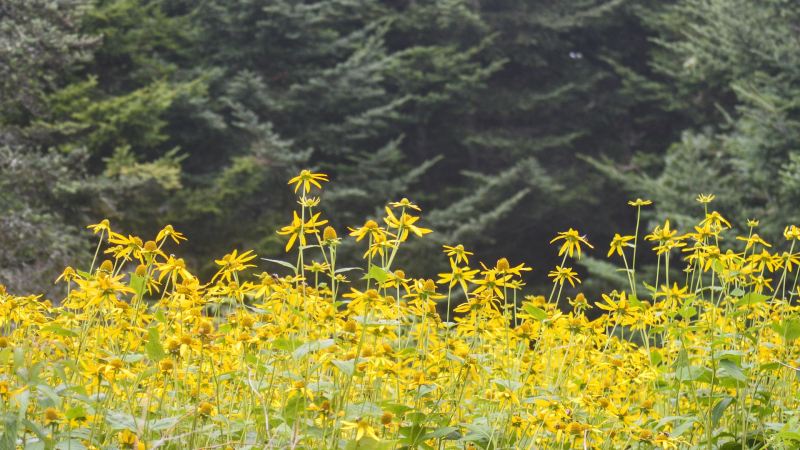
National parks are full of majestic landscapes and are among the most sought-after vacation spots in the country. But as beautiful as they are, these parks often suffer from a curse of their own success — overcrowding. The sheer volume of visitors can sometimes shatter the tranquility of nature, making it difficult to fully appreciate the serenity you sought. Fortunately, we have compiled a list of the best hiking spots in national forests, where you can escape the throngs of tourists in the national parks and reconnect with the great outdoors.

Pisgah National Forest: North Carolina
Catawba Falls Trail
With an elevation of 1,932 feet and a hiking distance of just 3 miles, the Catawba Falls Trail is a perfect escape from crowded national parks. Located in the southeastern reaches of the Blue Ridge Mountains, this trail leads to the enchanting Catawba Falls, formed by the headwaters of the Catawba River. Along the way, hikers are treated to the sight of not one, but two beautiful waterfalls, making this hike a must-visit for nature enthusiasts.
South Toe River Loop
For a longer but equally serene hike, the South Toe River Loop offers an elevation of 3,282 feet and a 3.5-mile journey. Starting and ending at the Black Mountain Campground, this trail winds its way along the river, flanked by towering trees and majestic mountains.
Graveyard Fields Trail
With an elevation of 5,289 feet and a

Shawnee National Forest: Illinois
Little Grand Canyon Trail
Shawnee National Forest in Illinois is full of amazing hikes, and the Little Grand Canyon Trail is no exception. This 3.4-mile loop trail near Pomona offers a moderately challenging route that rewards hikers with awe-inspiring views. While it’s a popular area, the natural beauty of this trail makes it worth sharing with fellow outdoor enthusiasts.
Garden of the Gods
Head out on the 6.4-mile loop trail near Equality, Illinois, and you’ll find yourself in the enchanting Garden of the Gods. This moderately challenging route takes an average of 2 hours and 41 minutes to complete, and it’s a favorite spot for hikers, horseback riders, and walkers alike. While you might encounter other adventurers along the way, the stunning rock formations and sweeping views will make it all worthwhile.
Jackson Falls Trail
If you’re interested in birding, camping, or

El Yunque National Forest: Puerto Rico
Mount Britton Tower Trail
Escape the crowds on this 1.6-mile out-and-back trail near Naguabo, East Region, of Puerto Rico. This moderately challenging route leads to Mount Britton Tower, offering stunning views of the surrounding rainforest. While it’s a popular area for
El Yunque Trail
Venture along this 5.4-mile out-and-back trail near Carata de la Mina, East Region. With a moderately challenging rating and an average completion time of 3 hours and 24 minutes, it’s a popular spot, so you’ll likely encounter other hikers. However, the year-round accessibility and the sheer beauty of El Yunque National Forest make it a must-visit destination.
Angelito Trail
For an easy and quick escape into nature, try the 0.7-mile out-and-back Angelito Trail near Luquillo, East Region. While this trail is popular, taking an average of just 20 minutes to complete, the beauty of El Yunque National Forest is undeniable. Even with the potential for other hikers, the tranquil atmosphere and lush surroundings provide a sense of solitude.

Sequoia National Forest: California
Tokopah Falls
Located near Hartland, California, this 3.8-mile out-and-back trail is moderately challenging and takes approximately 1 hour and 44 minutes to complete. While this trail is popular for
Congress Trail
The 2.9-mile loop trail near Hartland, California, is an easy route that takes an average of 1 hour and 19 minutes to complete. This is a popular destination for
Marble Falls Trail
For a longer and more challenging hike in Sequoia National Forest, try the 6.3-mile out-and-back Marble Falls Trail near Stony Creek Village, California. With an average completion time of 3 hours and 23 minutes, this trail is popular among

Closing thoughts
When national parks become too crowded, it’s time to explore the lesser-known adventures within our national forests. Whether you’re in North Carolina, Illinois, Puerto Rico, or California, there are plenty of hiking trails waiting to be explored. These trails offer the perfect opportunity to escape the crowds, immerse yourself in the beauty of nature, and create unforgettable outdoor adventures.
For more



